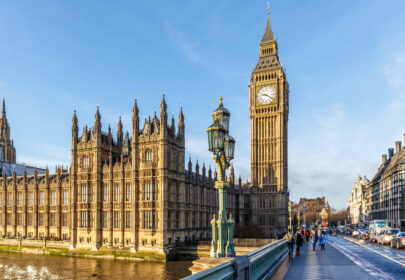Blog
Don’t leave your family an avoidable IHT bill

At a glance
- In the last tax year (2022-23) bereaved families paid £6.1 billion in Inheritance Tax, the largest single-year rise since 2015-16.1
- Reducing the value of your estate during your lifetime will mean that your family will owe less IHT in the future.
- Many people know that they can gift money to reduce the size of their estate, but not everyone knows how workplace pensions and death-in-service benefits can be ringfenced to avoid IHT.
Many people know that they can gift money to reduce the size of their estate, but not everyone is aware that workplace pensions and death-in-service benefits can also be shielded from IHT.
Will my death-in-service benefit mean a higher IHT bill?
Your death-in-service benefit is where a nominated beneficiary receives a lump sum should you die while still working for your employer. That lump sum then becomes part of your beneficiary’s estate. When they die, the value is assessed to IHT.
Although intended to help your family financially after your death, a lump sum payment from a death-in-service benefit or a workplace pension pay out, can actually be a mixed blessing.
The more your estate is worth, the higher the amount of IHT your family may need to pay. And nobody wants the taxman to be their largest beneficiary.
The same applies if your workplace pension would be paid as a lump sum to your beneficiary when you die.
Can I protect my death-in-service or pension lump sum from IHT?
Currently, IHT is charged at a rate of 40% on the portion of the estate over a £325,000 threshold, or up to £500,000 if it includes a family home worth at least £175,000 that is being passed on to children or grandchildren or other direct lineal descendant. However, transfers between spouses and civil partners are excempt from IHT.
“Death-in-service benefits are often multiples of salary, so even if people don’t currently have any issues with IHT, a payment from one of these schemes can push their estate over the nil rate band i.e the £325,000 threshold,” explains Claire Trott, Divisional Director – Retirement and Holistic Planning at St. James’s Place, “and suddenly they have a much larger IHT bill to pay.”
How a legacy preservation trust from SJP can help
Trusts can play an important role in legacy planning. And a legacy preservation trust or LPT from St. James’s Place, does exactly what it says on the tin – preserves your legacy so more money can pass to the people you love.
An SJP Legacy preservation trust is designed to hold assets such as death-in-service and pension death benefits so that your beneficiaries can access the money if they need to. But the money itself sits outside your estate, protected from tax, including IHT.
How do I set up a legacy preservation trust?
An SJP financial adviser can easily set up a legacy preservation trust for you. You’ll need to choose two trustees who will be responsible for the distribution of your money after you have died. You also need to inform your employer of your arrangements with an ‘expression of wishes’ form from your pension provider, and your HR department may be able to help you do this. This ensures that the money is paid into the LPT rather than to an individual beneficiary.
SJP’s Legacy preservation trusts put you in control of your estate
LPTs aren’t just for the very wealthy. They have other very useful benefits that can help with other financial planning as well as reducing your IHT bill.
If, for example, you have children from a previous relationship or marriage, you may worry about what happens to your wealth if one of your beneficiaries splits up from their partner. Or you might have some concerns about their ability to manage their finances. A St. James’s Place LPT gives you more say over how and when your money is distributed, and to whom. “Money can otherwise quickly drift into other families,” Claire explains.
Putting money in an LPT can help fund later life care
If you put money into an LPT, it isn’t part of your estate or your beneficiary’s. So it won’t be counted if your beneficiary is means-tested for local authority social care, as they get older.
With an LPT, the distribution of your the assets within the trust is controlled by your chosen trustees. They make decisions based on the instructions you leave behind. It’s important that you leave a letter of wishes, which you keep updated, for trustees to refer to. It gives you peace of mind that your wishes will be respected when you’re no longer around.
We recommend that you review your letter of wishes whenever there’s a big family event. “Think about it every time there is a change within the family such as marriage, divorce, or new grandchildren. This is a good opportunity to consider who you want to benefit,” Claire advises.
Setting up a St. James’s Place LPT
A financial adviser will be happy to help you through the process. As a form of discretionary trust, an LTP may be subject to certain tax charges – but these can often be offset by the benefits.
They will also be able to advise you if the trust becomes unnecessary – for example, when you have retired and death-in-service benefits are no longer relevant, or if your tax position changes.
Claire says clients sometimes think that the admin involved in setting up a trust is a hassle. But overall, the positives outweigh any negatives: “I like to think of it as a back-up plan. Often you don’t appreciate why you need one until the time comes. It can be very good in complex family situations because it allows a third party trustee – whom you trust – to make the right decisions on your behalf.”
Get in touch with us
If you’d like more information on planning inheritance tax, or if you want to see how a St. James’s Place LPT can save your family tax or help you control your wealth, just get in touch with us.
The Legacy Preservation Trust is an advised SJP product, available through a St. James’s Place Partner.
The levels and bases of taxation, and reliefs from taxation, can change at any time and are generally dependent on individual circumstances.
Trusts are not regulated by the Financial Conduct Authority.
Source:
1Inheritance Tax statistics: commentary – GOV.UK (www.gov.uk), accessed 28 June 2023
SJP Approved 29/06/2023
Tea or Coffee?
Why not get in touch to discuss your requirements? We understand that life is busy, that's why we're happy to meet in person or virtually. Let's start to plan your future together.















































































































